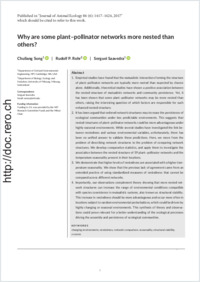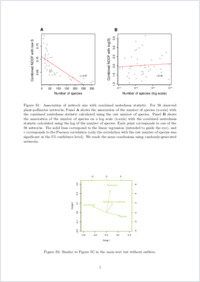Why are some plant–pollinator networks more nested than others?
- Song, Chuliang Department of Civil and Environmental Engineering, MIT, Cambridge, MA, USA
- Rohr, Rudolf P. Department of Biology, Ecology and Evolution, University of Fribourg, Switzerland
- Saavedra, Serguei Department of Civil and Environmental Engineering, MIT, Cambridge, MA, USA
-
01.11.2017
Published in:
- Journal of Animal Ecology. - 2017, vol. 86, no. 6, p. 1417–1424
English
Empirical studies have found that the mutualistic interactions forming the structure of plant–pollinator networks are typically more nested than expected by chance alone. Additionally, theoretical studies have shown a positive association between the nested structure of mutualistic networks and community persistence. Yet, it has been shown that some plant–pollinator networks may be more nested than others, raising the interesting question of which factors are responsible for such enhanced nested structure.It has been argued that ordered network structures may increase the persistence of ecological communities under less predictable environments. This suggests that nested structures of plant–pollinator networks could be more advantageous under highly seasonal environments. While several studies have investigated the link between nestedness and various environmental variables, unfortunately, there has been no unified answer to validate these predictions. Here, we move from the problem of describing network structures to the problem of comparing network structures. We develop comparative statistics, and apply them to investigate the association between the nested structure of 59 plant–pollinator networks and the temperature seasonality present in their locations.We demonstrate that higher levels of nestedness are associated with a higher temperature seasonality. We show that the previous lack of agreement came from an extended practice of using standardized measures of nestedness that cannot be compared across different networks.Importantly, our observations complement theory showing that more nested network structures can increase the range of environmental conditions compatible with species coexistence in mutualistic systems, also known as structural stability. This increase in nestedness should be more advantageous and occur more often in locations subject to random environmental perturbations, which could be driven by highly changing or seasonal environments. This synthesis of theory and observations could prove relevant for a better understanding of the ecological processes driving the assembly and persistence of ecological communities.
- Faculty
- Faculté des sciences et de médecine
- Department
- Département de Biologie
- Language
-
- English
- Classification
- Biological sciences
- License
-
License undefined
- Identifiers
-
- RERO DOC 306208
- DOI 10.1111/1365-2656.12749
- Persistent URL
- https://folia.unifr.ch/unifr/documents/306414
Other files
Statistics
Document views: 130
File downloads:
- pdf: 149
- Supplementary material: 127

